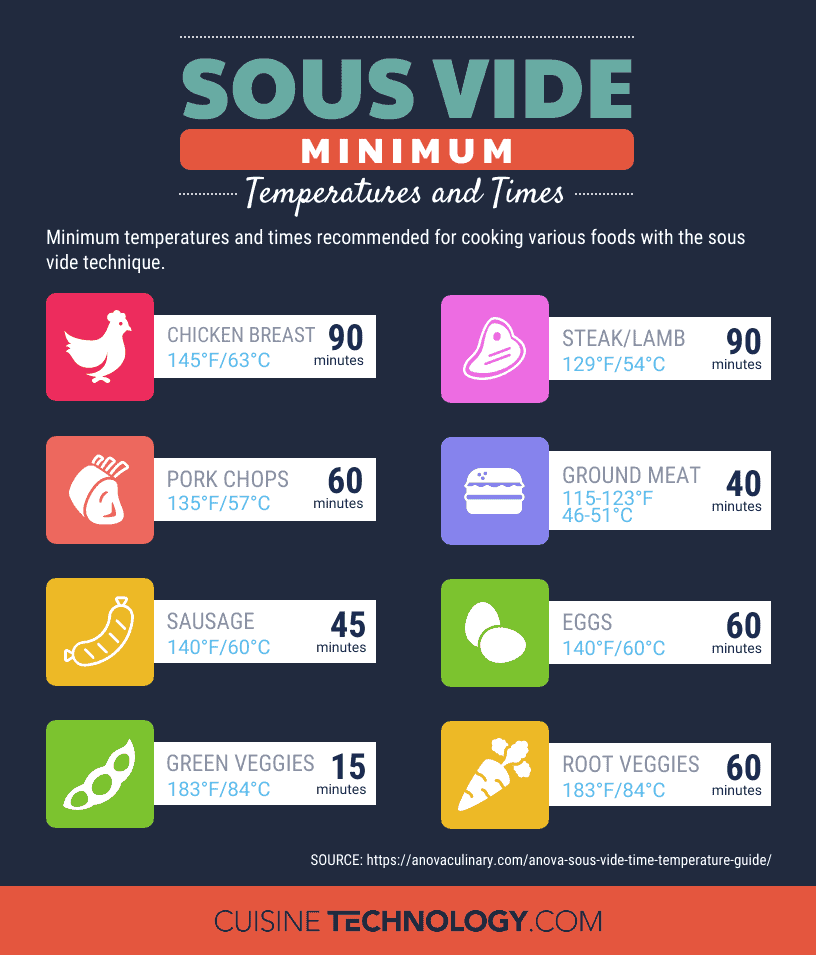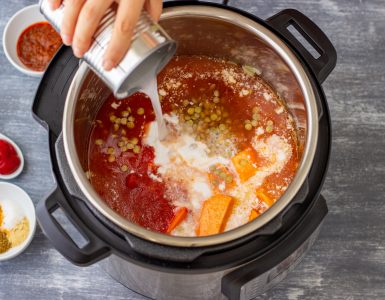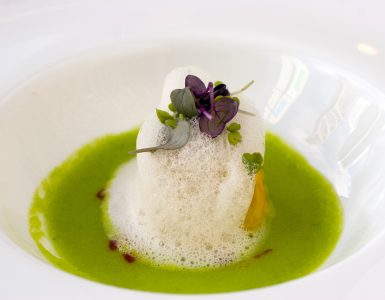This page may contain affiliate links. If you make a purchase through one of these links, we may earn a commission at no extra cost to you.
When you hear horror stories of botulism, salmonella, E. coli, and other serious food-borne bacteria and diseases, it’s no wonder food safety is a big concern! This is particularly true when you’re starting to experiment with a new cooking method, like sous vide. And it’s great that you’re cautious, because that means you’ll pay attention to sous vide food safety!
As long as you’re careful with your times, temperatures, and food handling, sous vide should be perfectly safe. But before you dive in, let’s talk in detail about exactly what that means for you and how you can ensure that you’re not accidentally creating a bag full of food poisoning instead of a delicious meal.
Keep in mind throughout this process that many food pathogens aren’t visible to the naked eye. Of course you shouldn’t eat moldy or visibly spoiled foods, but many of the harmful pathogens that you can encounter don’t leave obvious signs of their presence. This is why it’s so important to follow official food safety guidelines and recommendations even if the food in question “looks fine” and “smells fine.”
Table of Contents
Understanding the Food Temperature “Danger Zone”
The USDA explains that the food temperature “danger zone” is the range between 40°F and 140°F (4.4°C to 60°C). Within this range, the bacteria in food thrive, reproducing quickly and potentially contaminating the food.
To understand what this means for you, let’s turn to the Government of South Australia, which clearly lays out the following food safety guidelines.
If your food has been in the danger zone for…
Less than 2 hours: you can safely eat it, or refrigerate it to eat later. Refrigerating the food DOES NOT restart the clock, and the food can only be in the danger zone for up to 4 hours total before it needs to be discarded.
2 to 4 hours: you can safely eat it, but don’t put it back in the refrigerator. It must be consumed before it reaches 4 hours in the danger zone.
4+ hours: Any food that has been left in the danger zone of temperatures for more than 4 hours should be thrown away. At this point, it is NOT SAFE to eat even if you freeze it, cook it, or refrigerate it.

Food Temperature “Danger Zone” and Safety for Sous Vide
As you probably understand now, you absolutely should not sous vide food for over 4 hours at under 140°F/60°C. Even though it’s in the process of being cooked, it’s still in that danger zone and shouldn’t be consumed.
If your sous vide recipe calls for a temperature OVER 140°F/60°C:
You can leave your food in the safely hot water for many more hours (or even days in some cases). Whether a long cooking process is the best for flavor and quality is another question and depends entirely on what you’re making, but from a food safety perspective, a temperature over 140°F/60°C brings you safely out of the danger zone.
If your sous vide recipe calls for a temperature UNDER 140°F/60°C:
Your food is in the temperature danger zone.
Remember that foods that have been in the temperature danger zone for under two hours can be safely refrigerated and kept for later, as long as their total time in the danger zone doesn’t exceed four hours (and refrigerating them doesn’t restart the clock). So if you sous vide a steak for 90 minutes, for example, you can refrigerate it for later.
If you sous vide your food in the danger zone for more than 2 hours but under 4 hours, it’s safe to eat, but you need to consume it before it hits the 4-hour mark. You cannot safely refrigerate it for later.
If you accidentally leave your food in the sous vide bath in the danger zone for over 4 hours, it’s no longer safe to eat and needs to be thrown away.
Safe Temperatures for Specific Foods
Unfortunately, the food temperature “danger zone” and the associated time limits aren’t the end of the story when it comes to temperatures and sous vide safety. You probably know, for example, that chicken needs to be cooked at a higher temperature than steak to be safe.
J. Kenji López-Alt (of Serious Eats) has partnered with Anova to create a time and temperature guide for sous vide food safety. Remember that this chart functions in addition to the information about the temperature “danger zone,” and does not replace that information.
The minimum temperatures and times that they recommend for various foods are as follows:
- Chicken breast: 145°F/63°C for 90 minutes
- Steak and lamb: 129°F/54°C for 90 minutes
- Pork chops: 135°F/57°C for 1 hour
- Ground meat: 115-123°F/46-51°C for 40 minutes
- Sausage: 140°F/60°C for 45 minutes
- Eggs: 140°F/60°C for 1 hour
- Green vegetables: 183°F/84°C for 15 minutes
- Root vegetables: 183°F/84°C for 1 hour

Of course, you can cook most of your foods at higher temperatures or for longer times if you prefer (as long as you stay aware of the “danger zone” time limits), but these minimums should keep them safe. Check out Anova’s complete guide for much more information that will help you determine exactly what temperature to use to cook foods to your preferred doneness.
Another important point to discuss is that safely heated temperatures depend partly on time, not just temperature. Cook’s Illustrated explains in some detail how pasteurization works in regard to sous vide cooking. They give the example that chicken is safe almost instantly once its internal temperature hits 165°F/74°C.
However, that doesn’t mean the chicken needs to reach this temperature to be safe. It takes three minutes to achieve safety through pasteurization once the internal temperature of the chicken reaches 150°F/65.5°C. And if you choose to hold the chicken with an internal temperature of 136°F/58°C, it will take over an hour to be safely pasteurized. As you can see, the lower the temperature, the longer you need to keep the food there to pasteurize it.
In other words, even though chicken may become safe at an internal temperature 136°F/58°C, it does not become safe as soon as it reaches that temperature. Instead, it needs to stay at that temperature for over an hour. If you want to bring it to a temperature where it becomes safe almost immediately, you’ll need to bring it all the way up to 165°F/74°C.
As you may have gathered, all of this means that sous vide cooking sometimes walks a fine line between heating a food thoroughly and long enough to pasteurize it and make it safe while avoiding holding it in the “danger zone” for so long that it becomes hazardous.
Double-Check Your Temperatures
If you’re feeling any doubt about whether your sous vide food has cooked to a safe temperature, remove it from the cooking bag and check it with a food thermometer. If you need to cook it longer, place it in a new, clean bag and return it to the sous vide bath. (And don’t forget to sanitize anything that came into contact with the unfinished food or its juices! This includes your hands, the thermometer itself, and the surface on which you tested the food, along with anything else it came into contact with.)
This testing process is especially important for thick cuts of meat. You might be surprised by how much longer a thick cut takes than a thinner one, and a sous vide time and temperature guide that works for a 1” thick cut of meat won’t be accurate for a 2” thick piece. For this reason, it’s especially important that you check with a food thermometer to make sure that the center of the meat has reached the required temperature for safety.
Choose Your Bags Carefully
There are some concerns over whether certain types of plastic are safe at the prolonged heated temperatures that occur in sous vide cooking. Much of this concern comes down to two components: BPA and dioxin.
Ziploc-brand bags specifically are both BPA-free and dioxin-free, which makes them a popular choice for health-conscious sous vide enthusiasts. (In fact, these are what we often use ourselves.) If you don’t have access to this specific brand, CNET suggests that you should do your research to find another brand that’s made of high-density polyethylene, low-density polyethylene, and/or polypropylene, and avoid using any plastic bags made with polyvinyl chloride (PVC).
Of course, you can also use bags that are specifically designed for sous vide cooking. These should all be made with safe plastics, but again, please double-check to ensure that the brand you’ve found is safe.
Keep Your Food Bag(s) Submerged
It’s vitally important to keep your bags of sous vide food fully submerged throughout the cooking process. Because water transmits heat more effectively than air, any part of the bag that’s floating or exposed to air can end up at dangerously low temperatures. In addition to not cooking your food perfectly and consistently, this opens you up to health and safety hazards.
Some foods tend to be heavy enough on their own that they don’t float. If your bags are fully underwater, there’s no need to do anything more! Just keep an eye on them to make sure they don’t start floating partway through the cooking process.
If your bags are floating, though, you’ll need to weigh them down somehow. Options include clipping something heavy to the outside of the bag, putting something (heavy, food-safe, and sanitary!) inside the bag, or using special sous vide weights either inside or outside the bag.
Refrigeration After Cooking
Note: you don’t need to refrigerate sous vide food after you make it; you can absolutely finish it and eat it immediately! But if you’re going to keep it for later, follow the best practices for chilling and refrigeration.
You’re probably bored by now of being reminded that you can safely put food in the refrigerator as long as it hasn’t been in the temperature “danger zone” for more than two hours. However, it’s important to explain that you shouldn’t simply transfer bags of food straight from the sous vide bath into your refrigerator.
When you put a bag of hot food straight into the refrigerator, it will begin to cool down immediately. However, the cooling process may not be fast enough to bring the food out of the “danger zone” before it’s been in the unsafe range for too long. To be safer, you need to cool the food as quickly as possible to get it out of the “danger zone” and to a safely cold temperature.
To do this quickly and efficiently, The Kitchn recommends completely submerging your still-sealed sous vide bags into a container of ice water until the food is thoroughly chilled. (If the food is hot enough to cause the ice to melt, add more to ensure the water stays extremely cold.) This will cool the food much more quickly than the refrigerator alone would, bringing them out of the “danger zone” as fast as possible. Once the bags of food are thoroughly chilled in the ice bath, transfer them into the refrigerator or freezer and leave them there until you’re ready to reheat and consume the contents.
A Note About Garlic
Garlic can, unfortunately, be a culprit for botulism issues due to the tiny amounts of soil remaining on the bulb (yes, even if you clean it very well and only use the cloves). When botulinum is in an environment without oxygen, it can produce spores that can cause devastating health issues and even death. For this reason, garlic shouldn’t be held in an oxygen-free environment in the temperature “danger zone” for over two hours.
Of course, sous vide bags are a perfect environment for botulinum to produce spores. They contain very little oxygen thanks to removing the air, and are held in a cozy water bath that may be exactly the right temperature to encourage botulinum growth. And because these spores are invisible to the naked eye and have no discernable smell, you’ll have no idea if your food is contaminated.
The CDC states that “Heating to an internal temperature of 85°C [185°F] for at least 5 minutes will decontaminate affected food or drink.” Most sous vide preparations don’t reach this temperature, however, so they may not safely decontaminate affected food.
Sadly, this leads us to recommend avoiding the use of fresh raw garlic in sous vide preparations. Instead, either opt for garlic powder, add garlic as you finish cooking the meal in a pan after it’s done in the sous vide bath, or incorporate garlic into a sauce to pour over your sous vide foods. Another option is to pre-cook the garlic for the CDC-recommended temperature and time, then add it to your sous vide preparation.
External Factors
What happens in the sous vide cooking process itself isn’t the only factor that contributes to food safety. Here are some other important points to consider as you’re making sure that your sous vide food is as safe as possible!
Refrigerator temperature. Keep your refrigerator at or under 40°F/5°C to ensure that your food is cold enough. If your refrigerator is too warm, your food might already be in the danger zone without you even realizing it. This means that it can already have contamination issues before you even begin cooking it, and the cooking times that would have been safe otherwise are now incorrect.
General sanitation practices. All the best sous vide information won’t help you stay healthy if your overall kitchen sanitation practices are questionable. Follow all of the usual hygiene best practices to ensure that you don’t accidentally contaminate your food. This includes, for example, thoroughly washing your hands and surfaces, and avoiding any cross-contamination between raw and cooked foods.
Disclaimers
Some people—including children, pregnant people, the elderly, and people with certain health conditions—should avoid consuming undercooked food. Please consult with your doctor if you’re not sure whether certain foods and temperatures are safe for you, and err on the side of caution.
None of the information on this page should be taken as medical advice. Instead, it’s information gathered from expert sources (all of which are linked) to help you make your own informed decisions about cooking times and temperatures.
Summary
In short, sous vide cooking that follows best practices is safe. And while this article may have felt long, most of it is common sense, right? No doubt you already wash your hands and surfaces, cook chicken thoroughly, and keep your food refrigerated when you cook with other methods.
Certain sous vide immersion circulators and machines actually even tell you if you’re at risk of leaving your food in the temperature “danger zone” for too long. But with a little research and some understanding of the factors involved, you should be able to assess for yourself whether a particular recipe or cooking duration/temperature is safe.
As long as you follow government-published food safety guidelines and use sous vide recipes from trusted sources that take safety into account (we recommend and trust Anova and Serious Eats), sous vide cooking shouldn’t pose any extra health risk.










